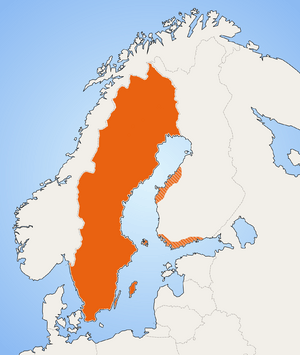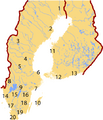Swedish language facts for kids
Quick facts for kids Swedish |
||||
|---|---|---|---|---|
| svenska | ||||
| Native to | Sweden, Finland | |||
| Native speakers | 11.1 million (2017) | |||
| Language family |
Indo-European
|
|||
| Early forms: |
Old Swedish
|
|||
| Writing system | Latin (Swedish alphabet) Swedish Braille |
|||
| Official status | ||||
| Official language in | Nordic Council |
|||
| Regulated by | Swedish Language Council (in Sweden) Swedish Academy (in Sweden) Research Institute for the Languages of Finland (in Finland) |
|||
| Linguasphere | 52-AAA-ck to -cw | |||

Major Swedish-speaking areas
|
||||
|
||||
Swedish is a language mainly spoken in Sweden and parts of Finland. You can find it along Finland's southern and western coasts, and on the Åland islands. Over nine million people speak Swedish.
Swedish is quite similar to two other Scandinavian languages: Norwegian and Danish. If you understand one of these, you can usually understand the others. However, other Scandinavian languages like Icelandic and Faroese are less similar. Swedish speakers might not understand them easily.
While standard Swedish is used across Sweden, there are also local dialects. These dialects have different grammar and vocabulary in smaller towns and rural areas.
Contents
Where Did Swedish Come From?
Swedish started as a dialect of Old Norse. Old Norse was a language that everyone in Scandinavia understood during the Viking Age. Around the 12th century, Swedish slowly began to change. It became different from other dialects. These dialects later grew into what we now call Norwegian, Icelandic, Faroese, and Danish.
Swedish is a Germanic language. It has some similarities to English because of the Vikings who visited England long ago. It is even more similar to German and Dutch. This is partly because of the Hanseatic League in the Middle Ages. During that time, Sweden traded a lot with Germany.
Special Letters in Swedish
The Swedish language uses three special letters that are not in the English alphabet. These letters are å, ä, and ö.
- The letter å makes a vowel sound between 'a' and 'o'. It sounds like the "awe" in the English word awe.
- The letter ä makes a vowel sound like the "e" in the English word bed.
- The letter ö makes a vowel sound between 'o' and 'e'. It sounds like the "u" in the English word burn.
These special characters are also used in the Finnish language. However, Norwegian and Danish languages use similar letters, æ and ø, instead of ä and ö.
How Swedish Grammar Works
Swedish grammar has some interesting differences from English. For example, definite articles are added to the end of nouns. So, ett hus (a house) becomes huset (the house).
Also, unlike English, Swedish uses two grammatical genders. These are called Common and Neuter. Nouns of the Common gender are sometimes called "en words." Many words for living things are "en words." Nouns of the Neuter gender are sometimes called "ett words."
Common Swedish Words
Here are some common words in Swedish and what they mean in English:
| Swedish | English |
|---|---|
| Ett/En | One |
| Två | Two |
| Tre | Three |
| Fyra | Four |
| Fem | Five |
| Sex | Six |
| Sju | Seven |
| Åtta | Eight |
| Nio | Nine |
| Tio | Ten |
| Ja | Yes |
| Nej | No |
| Jag | I |
| Du | You |
| Mig | Me |
| Han | He |
| Hon | She |
| Vi | We |
| De/dem | They/them |
| Jag är | I am |
| Sverige | Sweden |
| Hus | House |
| Hem | Home |
| Väg | Way |
| Björnar | Bears |
| Hjälp | Help |
Everyday Swedish Phrases
Here are some basic Swedish expressions you might hear:
| God dag/Hej | Good day/Hello |
| Hur mår du? | How are you? |
| Jag mår bra, tack | Very good, thank you |
| Tack | Thank you |
| Tack så mycket | Thank you very much |
| God morgon | Good morning |
| God eftermiddag | Good evening |
| Hej då | Goodbye |
Images for kids
-
Front page of Gustav Vasa's Bible from 1541. The title means: "The Bible / That is / The Holy Scripture / in Swedish. Printed in Uppsala. 1541".
-
August Strindberg, a very important writer in modern Swedish literature.
See also
 In Spanish: Idioma sueco para niños
In Spanish: Idioma sueco para niños







